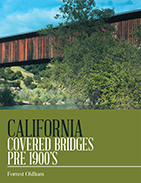
 |
Through words and pictures, this informative, attractive book tells the story of the covered bridges built in California in the late 19th century. Author Oldham’s interest in photography led to excursions around the state’s picturesque landscapes, where he noticed the state’s near-100 covered bridges. Assigning himself the task of photographing as many as possible, Oldham also delved into their history. The covered bridges his book documents were constructed following the Gold Rush of 1849. California’s population was expanding dramatically, and infrastructure was needed. Meeting this need, the bridges ranged in size from small footbridges to the Nyes Crossing Bridge; at 233 feet, this bridge holds the distinction as the longest freestanding covered bridge in the world. Oldham also describes several different methods of constructing bridges, clearly illustrating their architecture with diagrams. He also explains the purpose behind covering them. One would think this done for safety, but actually, bridges were covered because coverings protected the structural underpinnings of the bridges, and they were inexpensive to replace.
Oldham acknowledges that his book only begins to document its subject, but it points toward a more thorough study. The heart of the book lies in its crisp and well-composed photographs of the bridges’ exteriors and interiors. Oldham frames these structures beautifully in their surroundings, showing how time and weather have almost made them become a part of the landscape. More impressively, shots of the bridges’ intricate interiors evoke a sense of mystery and secrecy similar to the feelings inspired by The Bridges of Madison County. Though the book’s text does not quite match the romance of its images, the words do provide relevant context. This slim, appealing book should be of interest to anyone with a penchant for history, architecture, and beautiful photography.